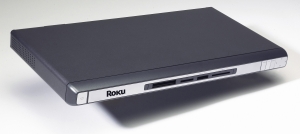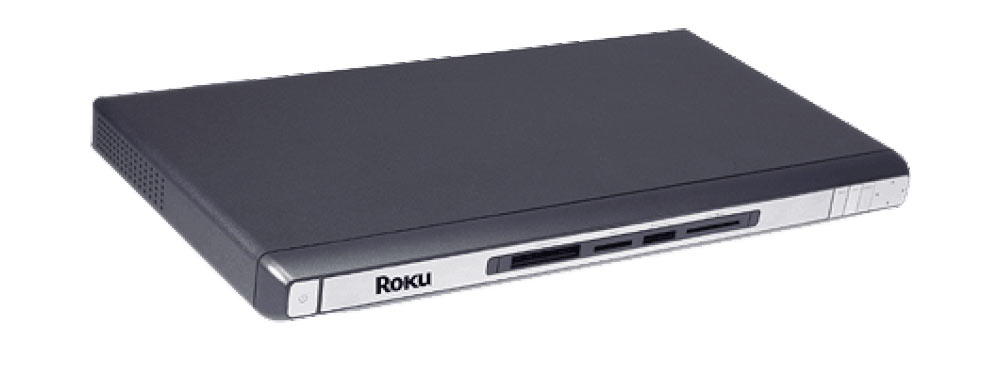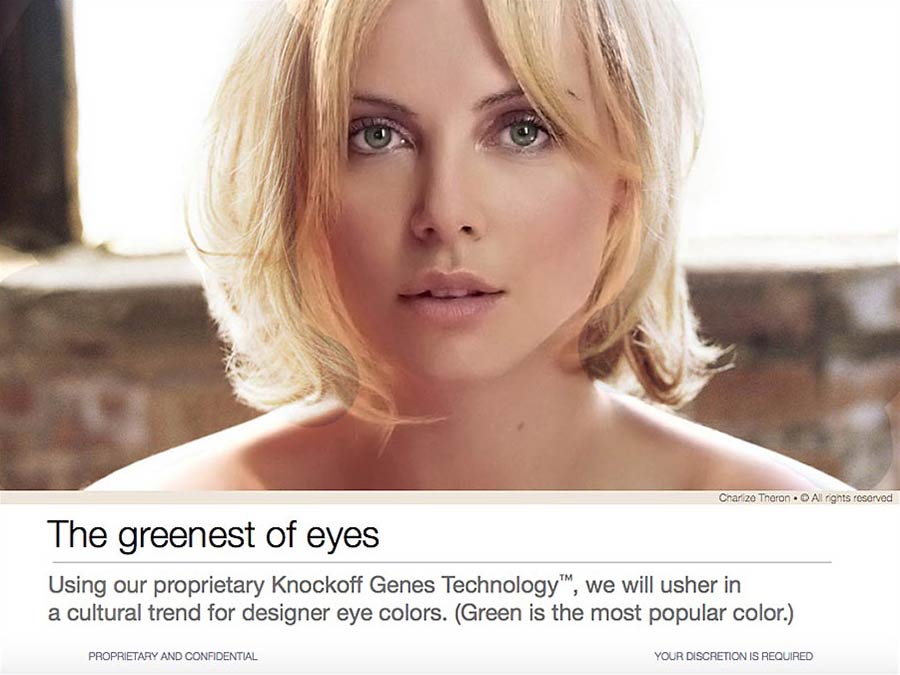For this week’s Engadget Inteview, veteran journalist J.D. Lasica spent a few minutes with Anthony Wood, founder and CEO of Roku, to discuss digital media, digital music, DRM wackiness and Mona Lisa smiles.

For readers who aren’t familiar with Roku, what are you guys about?
We’ve been around since October 2002 and we’re based in Palo Alto, Calif. Our focus is building digital media players for home. Our core expertise is to produce great-looking products and great user interfaces.
Such as?
Our product line includes the Roku SoundBridge and the HD1000. We tell people, wouldn’t you love to see a slide show of your family pictures in full-quality digital on your flat-panel TV in your living room? That resonates.
And Roku means what?
“Six” in Japanese. It’s the sixth company I’ve been involved with.
Tell us about your main product lines.
The HD1000 launched in October 2003 and now comes in two versions. The base version is $299, and the gallery version, at $499, is geared toward owners of HDTVs, flat-panel TVs and the like. A lot of folks love to display artwork on their flat-panel TVs when they’re not watching a show.
Sounds like what you might see on Bill Gates’ walls.
That’s right. The gallery collection comes with still images of classic art but also moving art of mountain streams and other looping high-def video clips.
What’s your favorite?
I like the clocks — you can add analog clocks with pictures of your kids in the background – and the geo-clock, with a map of the world showing where it’s day and night, and the robo clock. The most popular seller is the classic art packs — people get it, ‘Oh, the Mona Lisa on my TV.’ Second is the aquarium, followed by nature – like fields of poppies swaying in the breeze – and images from deep space, and clocks.
Plus, there are third-party apps you can download, like an app that retrieves weather from the Weather Channel with the current forecast for your area, and you can press buttons on your unit to see a satellite view. And there are third-party apps that display eight different webcams from around the world on your TV.
Just to be clear, this is not a personal video recorder.
Right. There’s no hard drive in it. Its purpose is to play media that you have on your computer or on a Memory Stick or Compact Flash card. You can take your digital photos, plug them in, and they’ll come up in high-def on your screen. Its primary focus is as a consumer-friendly media adapter.
When people think of high def, they think of television. But this isn’t about television.
Correct, although it will play back high-def video. If you record high-def video on your PC, you can play it back with this. But it’s less about MPEG-2 than about the other features we talked about: displaying family photos and art packs that look stunning on a flat-panel display.
 So you can’t play Hollywood high-def TV or movies on the HD1000.
So you can’t play Hollywood high-def TV or movies on the HD1000.
You can get an ATFC capture card for your PC and capture TV shows over the air and play them back on your PC. A lot of people use it to play back standard MPEG-2 DVD clips that they’ve ripped.
There are really two markets for this. There are people who want to display the art. And there are people who are ripping DVDs who buy the $299 version.
So it won’t play DVDs, but it will play DVD files that you’ve ripped.
Yes. It plays VOD files that you’ve ripped to your hard drive, and you need to connect your computer to a home network.
Is that legal?
I’m not a lawyer. These are DVDs that they’ve bought and are watching at home, not sharing with others.
That’s a pretty small market at this point.
This product is targeted toward the early adoption market. For the HD1000 product line, our run rate is 20,000 units a year. We’re going after flat-panel TV owners who want to use the TV for something other than watching something else.
What role does Roku play – software, hardware or both?
We write the software and design the hardware. We work with factories in Asia and contract out to build them. We have sales teams that sells them to dealers.
Where can people buy them?
You can find the HD1000 at Best Buy, Magnolia, Tweeter, Good Guys. Crutchfield, Fry’s or online from us.
Let’s move to the SoundBridge.
Sure. The SoundBridge started shipping in August. There are two versions, for $250 and $500. Both products are designed to play music you have stored on your computer in another room in the house. You can listen to your iTunes collection in your bedroom or your kitchen. You hook them up to a pair of power speakers or your stereo.
They come in two display sizes, both of which support iTunes directly – we’re the only music player with a license from Apple that a protocol that supports iTunes. It’s plug and play. If you have Wi-Fi, you plug it in a wall socket, turn on iTunes and it’ll find it and play it.
The big one is 17 inches, designed to go on a rack. The small one people usually place on a table with power [multimedia] speakers.
How does this sound through a good pair of Bose speakers? I imagine pretty shitty if you’re playing MP3 files from Kazaa.
It depends on the bit rate. Some customers play a .wav file or uncompressed AFF file. If you’re ripping CDs, with iTunes’ AAC format you can get a 192kps bit rate. It’s up to the user what quality level they want.
How is the SoundBridge selling?
Between now and Christmas we’ll sell 25,000 and next year 100,000 to 150,000.
How does the SoundBridge compare to the other music players on the market?
There are only a couple of others out there from the networking companies, Linksys [a division of Cisco Systems] and Netgear. So they kind of look like routers. In terms of industrial design, our products look really nice. The other guys don’t even play AAC files, just MP3 and WMA [Windows Media Audio].
Our other advantage is we have a big display that’s easy to read. You’ll see the name of the song, the artist, genre, album. Another other popular feature with the SoundBridge is Internet radio, about 100 stations. And finally, the SoundBridge has a very cool-looking vacuumed fluorescent display.
Does the SoundBridge play Windows Media files?
We’re adding it Oct. 12.
What about if you buy music from the online music stores – iTunes, Rhapsody, Napster, MusicMatch?
Unfortunately, today the songs you purchased are protected with DRM and will only play on authorized players. There are a lot of different DRM vendors, from Microsoft, Apple, Real and Sony.
Right now we don’t support DRM and there are no network streaming devices that support DRM, other than Rhapsody and one or two others. We’d like to support as many of the popular DRMS as possible. That will be done through software updates for existing products.
So you’re saying a user who buys songs legally from Napster can’t play them on the SoundBridge, but a user who downloads songs illegally from eDonkey can?
That’s right.
That’s nuts.
Even Apple doesn’t support streaming network devices. So if you buy songs from the iTunes store, you can’t play them on the SoundBridge, and we have an Apple license — but only for music you ripped off your CD.
Now, there are users who buy the songs and download free software off the Net that will strip off the DRM protection, and that way you can listen to them on the SoundBridge. But we don’t encourage that. But if you buy a song download, you can burn a CD without the DRM protection.
That’s not ideal. The DRM vendors are just starting to add support for third-party devices and we are in the process of adding it, but we don’t have a date yet.
When people who buy songs from the iTunes store or Napster can’t play them on their SoundBridge, won’t they be mad at you?
That’s why we tell them up front – on our website and on our product packaging — that this is a limitation if that’s what they want to do. We’re talking to Apple about opening their platform up.
What other devices are you working on?
We don’t announce upcoming products, but over time we expect to add new products to both our video and audio lines. Different versions, features, form factors. All our products are software updatable as well. The HD1000 is up to version 1.5, the SoundBridge is coming out with a big update this week.









[…] Anthony Wood — An interview with the founder and CEO of Roku, who discusses digital media, wireless music and DRM wackiness. […]